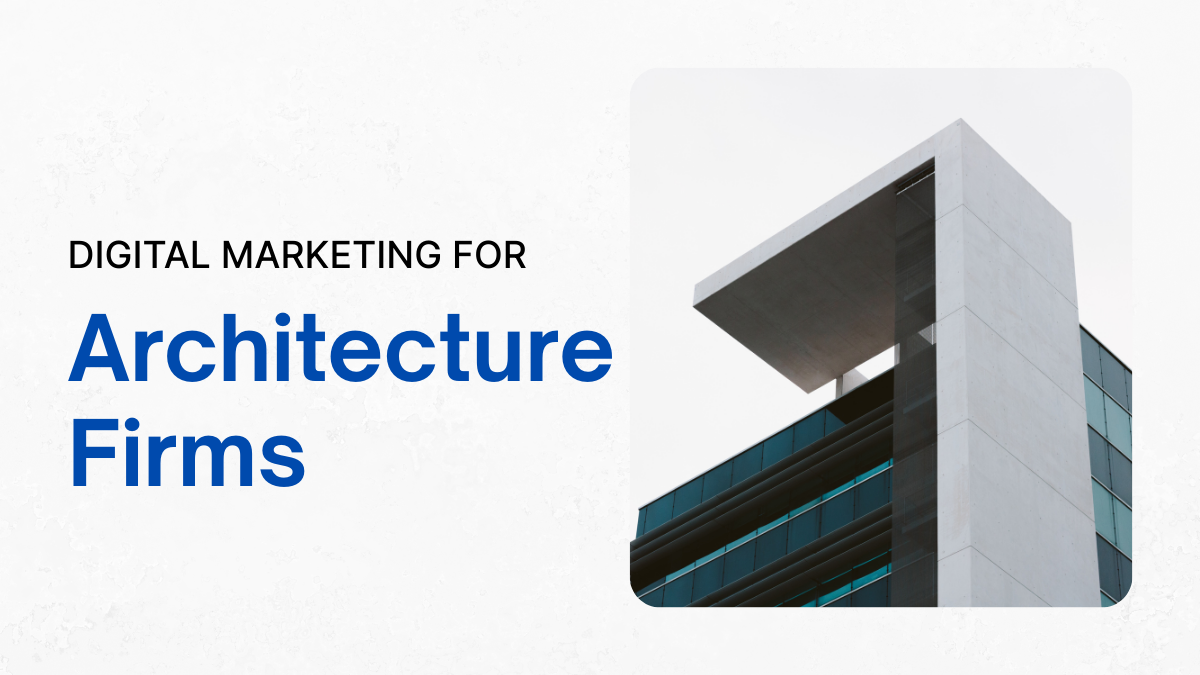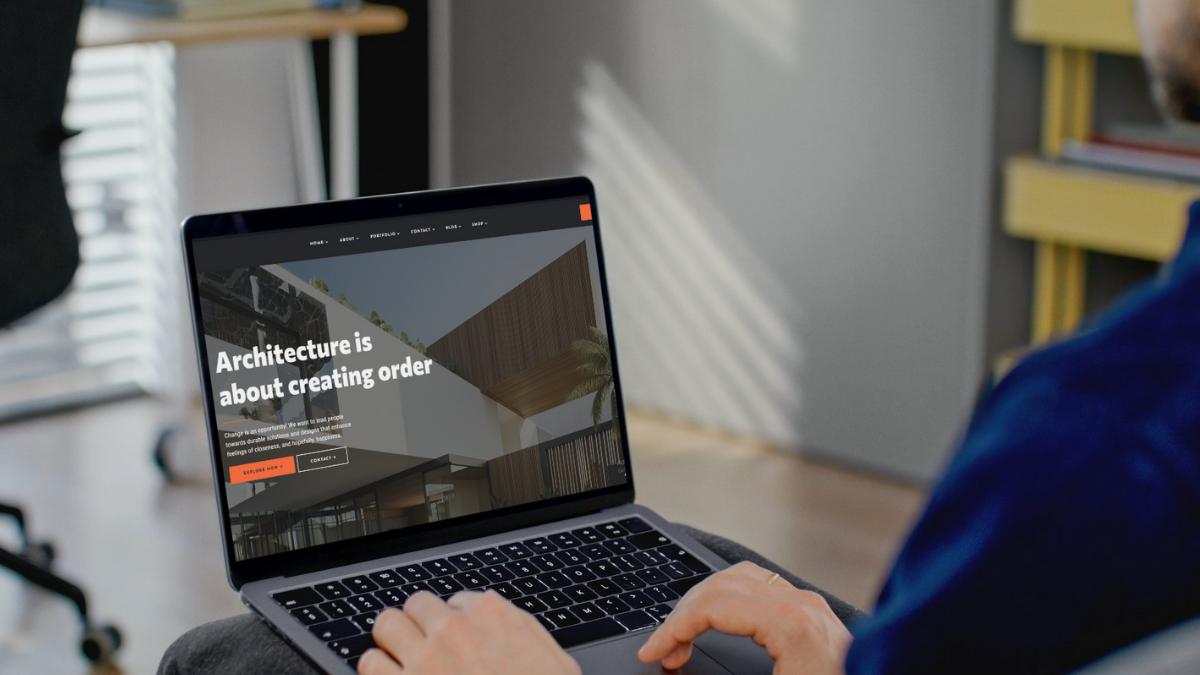
Digital Marketing for Architecture Firms
Your firm creates stunning, functional, and inspiring spaces. But if potential clients can't find you online, your best designs might remain just blueprints. In an industry built on reputation and visual portfolios, many architecture firms believe their work should speak for itself. While that's true, you first need to get people to see and hear it. That's where digital marketing comes in.
You don't need to be a tech expert or a marketing guru to build a powerful online presence. Think of digital marketing as the modern-day equivalent of a beautifully designed portfolio, a strong referral, and a feature in an esteemed magazine—all rolled into one accessible strategy. It’s about meeting your clients where they are: online.
This guide will walk you through the essential components of digital marketing for architecture firms. We'll break down how to create a standout website, use social media to showcase your work, attract local clients with SEO, build a brand that resonates with your ideal project partners, and introduce advanced strategies like email campaigns and influencer collaborations. Along the way, you'll find detailed examples, real-life case studies, and practical tips you can apply right now.
Your Website: The Digital Front Door

Before anything else, your website is your most critical digital asset. It’s your firm's online headquarters, your portfolio, and your primary lead generation tool. A clunky, outdated, or hard-to-navigate site can turn off a potential client in seconds, no matter how impressive your projects are.
First Impressions Matter: Design and User Experience
Your website's design should reflect the quality and style of your architecture. It needs to be clean, professional, and visually driven.
-
Simplicity is Key: Use a minimalist design that lets your project images take center stage. Avoid clutter, confusing navigation, and too many competing elements.
-
Make it Easy to Use: Visitors should be able to find what they're looking for within a few clicks. Your main navigation should clearly label sections like "Projects," "Services," "About Us," and "Contact."
-
Mobile-Friendly is Non-Negotiable: A significant number of your visitors will be browsing on their phones or tablets. Your website must be responsive, meaning it automatically adjusts to fit any screen size. A poor mobile experience can damage your credibility instantly.
Example:
Studio Forma, a boutique architecture firm, redesigned its website with a cleaner look, easy navigation, and large images of completed projects. The result? A 35% increase in average visit duration and more client inquiries via the contact form.
Actionable Tip:
Periodically have friends, family, or colleagues review your website on both desktop and mobile. Ask them to find a recent project, your contact info, and a list of services. Note anything that takes more than a few clicks—that's where to focus your improvements.
Showcase Your Work with a Stunning Portfolio
Your project portfolio is the heart of your website. This is where you prove your expertise and captivate potential clients.
-
Use High-Quality Visuals: Don't skimp on professional photography and videography. Grainy, poorly lit photos will do a disservice to your work. Invest in capturing your projects in their best light. Include a mix of exterior shots, interior details, and even before-and-after images.
-
Tell a Story: For each project, don't just dump a gallery of photos. Write a brief project description. What was the client's vision? What challenges did you overcome? What makes this project unique? This context adds depth and helps clients connect with your process.
-
Organize Your Projects: If you work across different sectors—like residential, commercial, and public spaces—organize your portfolio accordingly. This allows visitors to easily find examples relevant to their needs.
Case Study:
When integrating short videos showing time-lapse progress of a complex office renovation, an architecture firm in Chicago noted a spike in their project page shares on LinkedIn and a 20% increase in requests from similar commercial clients.
Actionable Tip:
After finishing every project, schedule a photoshoot and gather testimonials from the client. Update your web portfolio regularly rather than waiting until you have several completed projects.
Getting Found: Search Engine Optimization (SEO)

Having a beautiful website is great, but it's not enough if no one can find it. Search Engine Optimization (SEO) is the process of making your website more visible on search engines like Google when people search for services you offer.
Think Like Your Client: Keywords
What would a potential client type into Google? They probably won't search for your firm's name unless they already know you. They're more likely to search for terms like:
-
"Residential architect in [Your City]"
-
"Modern home design [Your State]"
-
"Commercial building architects near me"
-
"Sustainable architecture firm"
These are your keywords. Your goal is to naturally incorporate these phrases into your website's content, especially on your homepage, service pages, and in your project descriptions.
Example:
A firm in Austin, Texas, updated their service pages to include local keywords. Instead of just “Home Design,” they used “Modern Home Design in Austin.” Within four months, their ranking for location-based searches significantly improved and brought in more local leads.
Actionable Tip:
Use free tools like Google Keyword Planner or Ubersuggest to find popular search phrases in your area related to architecture. Update your website copy and blog posts to include these phrases naturally.
The Power of Local SEO
Most architecture firms serve a specific geographic area. Local SEO helps you appear in front of clients who are searching for architects in your region. The most important step here is to create and optimize your Google Business Profile.
This free listing allows you to show up in Google Maps and the "Local Pack" (the box with three local businesses that appears at the top of search results). Make sure your profile is complete with:
-
Your firm's name, address, and phone number (NAP).
-
Your business hours.
-
A link to your website.
-
High-quality photos of your team and your best projects.
-
Positive reviews from past clients (don't be afraid to ask for them!).
Case Study:
MetroArch attracted multiple large commercial projects after making regular posts and updates to their Google Business Profile, along with encouraging satisfied clients to leave reviews. Their visibility in local Maps searches skyrocketed, resulting in more calls and consultation bookings.
Actionable Tip:
After each successful project, send a personalized message thanking your client and asking if they’d be comfortable leaving a review on Google. Make it easy for them by providing a direct link.
Building Your Brand on Social Media

Social media is not just for influencers and consumer brands. For architects, it's a powerful visual platform to build brand awareness, showcase your design aesthetic, and connect with a wider community. You don't need to be on every platform. Focus on the ones that make the most sense for a visual industry.
Instagram and Pinterest: Your Visual Storytelling Tools
Instagram and Pinterest are built for aesthetics, making them perfect for architecture.
-
Instagram: Use high-quality images and videos of your finished projects. Share behind-the-scenes content, like design sketches, 3D renderings, or construction progress. Use Instagram Stories to give a more informal look into your firm's culture and daily life.
-
Pinterest: This platform is a search engine for ideas. Users create boards for home inspiration, office designs, and dream projects. By sharing your work on Pinterest, you can get it in front of people who are actively planning a future project. Create boards for different styles or project types, like "Minimalist Kitchen Designs" or "Modern Office Spaces."
Example:
A San Francisco studio saw their Instagram followers grow from 1,000 to 7,500 in one year by consistently sharing project progress posts, before-and-after transformation images, and short reels demonstrating their design process.
Actionable Tip:
Set a realistic posting schedule—aim for two to three posts per week on Instagram and one new board or pin collection per month on Pinterest. Use relevant hashtags like #ArchitectureDesign, #ModernHomes, and your city’s name.
LinkedIn: The Professional Network
While Instagram and Pinterest are for visual inspiration, LinkedIn is for building professional credibility. Use it to:
-
Share firm news and accomplishments: Did you win an award or get featured in a publication? Share it here.
-
Connect with industry partners: Build relationships with builders, engineers, and potential commercial clients.
-
Write and share articles: Position yourself as a thought leader by writing about trends in architecture, sustainable design, or project management.
Case Study:
By posting design insights, joining local industry groups, and spotlighting employee achievements, Bridgeway Architecture attracted new commercial partnerships and speaking invitations at industry conferences.
Actionable Tip:
At least once a month, publish a short article or a project case study on LinkedIn. Tag collaborators and clients if appropriate to boost reach and engagement.
Content Marketing: Show, Don't Just Tell

Content marketing is about creating valuable content that demonstrates your expertise and builds trust. For an architecture firm, this often means going deeper into your process and philosophy.
A blog on your website is a great place to start. You can write about topics that answer your potential clients' questions, such as:
-
"What to Expect When Working with an Architect"
-
"5 Key Elements of Sustainable Home Design"
-
"How to Budget for Your Custom Home Project"
-
"Choosing the Right Materials for Your Commercial Building"
Example:
Writing a blog series called “Behind the Blueprints” helped a small studio build authority and organic traffic, and the articles were even shared in a local magazine, attracting new project opportunities.
Actionable Tip:
Brainstorm ten common client questions and turn each into a blog post over the next few months. Repurpose these posts into bite-sized content for social media, newsletters, or client handouts.
Targeted Advertising: Reaching Your Ideal Client
While organic strategies like SEO and content marketing are great for long-term growth, sometimes you need to get in front of the right people quickly. Paid advertising allows you to do just that.
-
Social Media Ads: Platforms like Facebook and Instagram allow you to target ads with incredible precision. You can target users based on their location, age, income level, and even interests (like "architecture," "interior design," or "real estate investing"). This is perfect for promoting a specific project or service to a niche audience.
-
Search Engine Ads: With Google Ads, you can pay to appear at the top of the search results for your most important keywords. This is ideal for capturing "high-intent" clients—people who are actively searching for an architect right now.
Example:
A firm launched a targeted Instagram ad campaign featuring a timelapse video of a modern home renovation. The ad generated dozens of leads in a week and led to three new project consultations.
Actionable Tip:
Test a small paid campaign with a budget of $100–$200 for one month. Promote your best-performing project or a special offer for consultations and track which ads drive the most clicks or bookings.
Email Marketing: Staying Top of Mind

Many architecture firms overlook email marketing, but it’s a highly effective way to nurture relationships.
-
Monthly Newsletters: Share recent projects, industry trends, awards, or helpful tips for homeowners and developers.
-
Project Updates: Keep existing clients informed about progress and milestones to build trust and encourage referrals.
-
Lead Nurturing: Send regular updates to past leads who didn’t convert, keeping your firm top of mind for future opportunities.
Example:
Lighthouse Design sends a quarterly email roundup featuring new portfolio projects, blog articles, and community events. After six months of consistent emails, they noticed a spike in referrals and return clients responding directly to newsletter updates.
Actionable Tip:
Start building an email list by offering a free design checklist or eBook in exchange for contact information on your website. Use a simple newsletter template and schedule regular updates.
Video Marketing: Bringing Architecture to Life

Video content can set your firm apart by giving potential clients a richer experience than still images alone can offer.
-
Project Walkthroughs: Short tours of finished spaces let viewers "walk" through your work.
-
Client Testimonials: Video testimonials build credibility and showcase client satisfaction.
-
Educational Content: Share tips on working with architects, design principles, or sustainability features.
Example:
A mid-sized firm uploaded a three-minute walkthrough video of a completed apartment complex on their website and YouTube channel. The video received thousands of views and led to inquiries from a local property developer.
Actionable Tip:
If you don’t have the budget for professional video, use your smartphone and natural lighting to record simple but engaging clips. Authenticity matters more than flashy equipment.
Collaborations and Influencer Partnerships
Expanding your reach often means partnering with others who already have the audience you want to reach.
-
Industry Blogs: Guest posting on real estate, home building, or local lifestyle blogs puts your expertise in front of new audiences.
-
Social Media Influencers: Team up with local interior designers, builders, or even lifestyle influencers. They can showcase your projects or host collaborative “Ask the Architect” sessions.
-
Virtual Events & Panels: Participate in webinars or live streams with other local businesses or organizations to grow your reputation and authority.
Example:
An architecture firm partnered with a well-known sustainability blogger for a behind-the-scenes video tour of their latest green home. The cross-promotion resulted in a 20% increase in web traffic and several press mentions.
Actionable Tip:
List the top five blogs, influencers, or businesses your ideal clients follow. Reach out with a personalized pitch for collaboration, whether it’s a guest article, co-hosted event, or project feature.
Measuring Success & Adapting Your Strategy

It’s not enough to just implement digital marketing—you need to measure your results so you know what’s working and where to improve.
-
Track Website Analytics: Use Google Analytics to monitor how many people visit your site, which pages are most popular, and where visitors come from.
-
Monitor SEO Rankings: Regularly check which keywords you rank for and how you compare to local competitors.
-
Evaluate Social Media Engagement: Track followers, likes, shares, and—more importantly—inquiries that come from social channels.
-
Review Email Open and Click Rates: See which topics or news drive the most engagement.
-
Set Clear Goals: For each campaign—be it a social ad, blog series, or influencer partnership—define what success looks like (e.g., more website visits, project inquiries, or newsletter signups).
Actionable Tip:
Set aside time each month to review your digital marketing metrics. Take note of any spikes in web traffic after a new blog post, an increase in inquiries following an email campaign, or which social posts get the most engagement. Use this data to adapt your strategy—do more of what works and don’t hesitate to try new ideas if something falls flat.
Final Thoughts
Feeling overwhelmed? Don't be. You can start small and build momentum.
-
Audit Your Website: Look at your site with fresh eyes. Is it mobile-friendly? Is your portfolio easy to find and impressive? Start there.
-
Claim Your Google Business Profile: This is a quick, free, and high-impact task. Do it today.
-
Choose One Social Platform: Don't try to master all of them at once. Pick Instagram or Pinterest and commit to posting high-quality images of your work consistently.
-
Write One Blog Post: Think of a common question you get from clients and write a helpful article that answers it.
-
Send One Email Newsletter: Announce a recent project completion, new hire, or community initiative to your network.
-
Test a Small Paid Ad Campaign: Promote your firm to a targeted local audience. Analyze the results to learn what gets the most attention.
Digital marketing for architecture firms isn't about flashy gimmicks. It’s about thoughtfully translating the principles you already use in your design work—clarity, function, and beauty—into your online presence. By doing so, you can attract better clients, win more exciting projects, and build a lasting brand in the digital age. Start with one or two tactics, track your progress, and let your results—and your passion for great design—guide the way forward.
30 minutes
Expert Consultation
Terms & Agreements
By booking a free 30-minute consultation, you agree to our terms, including scheduling, cancellation policies, and confidentiality. The session provides expert advice without guarantees of specific outcomes or results.






Leave a Reply
Your email address will not be published. Required fields are marked *